 "TJDMAX" (tjdmax)
"TJDMAX" (tjdmax)
02/07/2014 at 14:02 • Filed to: None
 14
14
 13
13
 "TJDMAX" (tjdmax)
"TJDMAX" (tjdmax)
02/07/2014 at 14:02 • Filed to: None |  14 14
|  13 13 |
So I have been reading/following Jalopnik/Opposite lock/Truck yeah for quite a while now and there have always been posts or articles that I wanted to comment on but I never felt obliged to give my opinion so I refrained from making an account and just continued reading, learning, and observing the sites. But within the past few days there have been a few vehicles (ok trucks in particular) that have made some claims about being a "Raptor Challenger" and being a truck enthusiast I could no longer bite my tongue and felt that I wanted to share this knowledge on why there has yet to be any truck (possibly the exception of the Ram Runner...) that could be considered a competitor to Ford's Raptor.
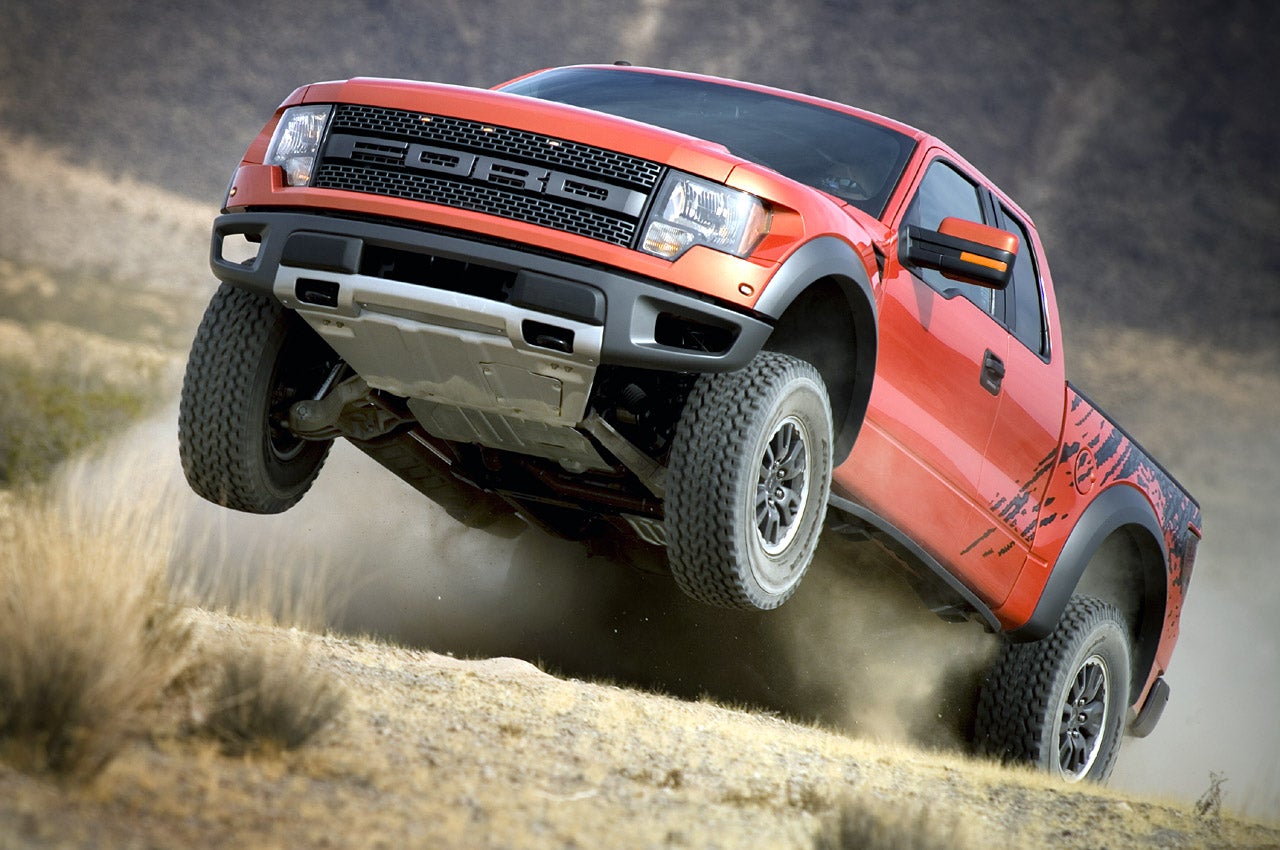
The first truck that tipped me off was the newly released TRD Pro model trucks. Now, while Toyota themselves never officially claimed that they were making a vehicle for the sole purpose of competing with the Raptor, the images, and "upgraded" suspension suggest that they are trying to maybe get into a little bit of that market. Now, disregarding the color of the truck or any of the exterior enhancements that it has Toyota did say that the truck gained more suspension travel by adding a 1.25" longer shock to the new Pro models. Here is my complaint with this advertising statement.
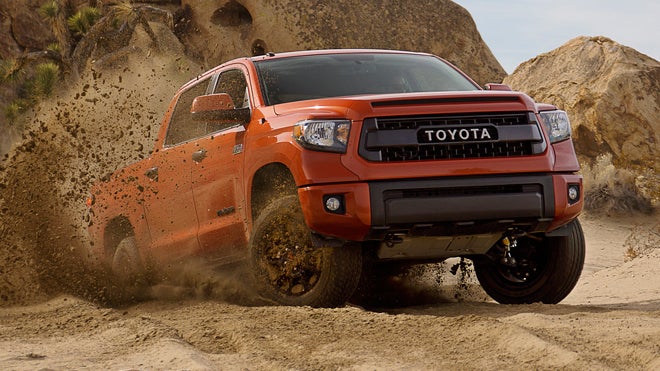
The Tundra is an independent front suspension truck, meaning that it has two control arms and a "coil around" shock that provides the damping as well as support for the front end. Each control arm is mounted to the frame at two fixed locations and travels in a given arc shaped path. By simply adding a longer shock to the tundra, one would not just magically see more travel. A Longer shock would only (for lack of a better word) push the wheel further down providing more "lift" but not more travel. Assuming the TRD Pro has the same control arms as a regular tundra or TRD Tundra the amount of travel that the suspension can have is always limited by the path of the control arms. So by pushing the wheel down more in its suspension path, you "increase" the up travel of the suspension but you lose droop or down travel of the suspension. And without changing the bump stops out for the up travel, really you don't gain anything at all, just changing how much up or down travel you have.
In layman's terms. If you had 10" of total travel (5" up, 5" down) adding a longer shock would just mean you have maybe 6" up travel and only 4" down travel when the vehicle is measured at rest sitting still on the ground at its ride height. Now also because of suspension geometry a 1.25" longer shock does not mean that the wheel was pushed down a full 1.25". Again because of the arc like path of the control arms there would have to be some math done to figure out the exact amount changed.
Of course "upgraded" shocks will provide a smoother ride both on and off road, which would allow the truck to be driven more comfortably at a higher rate of speed off road (would handle the bumps a lot better) I still don't see this truck with all its "changes" from a regular Tundra keeping up with a Raptor. These truck's also got 2" of lift (1.5 for the 4Runner) but that lift doesn't mean travel. The cheapest and simplest (and the way i'm guessing toyota lifted these vehicles) is to simply add a spacer either at the top or bottom of the coil over shock. Again, not changing any actual suspension components so gaining no travel over a stock tundra. The lift allows for larger tires but that's all....besides actually lifting it....
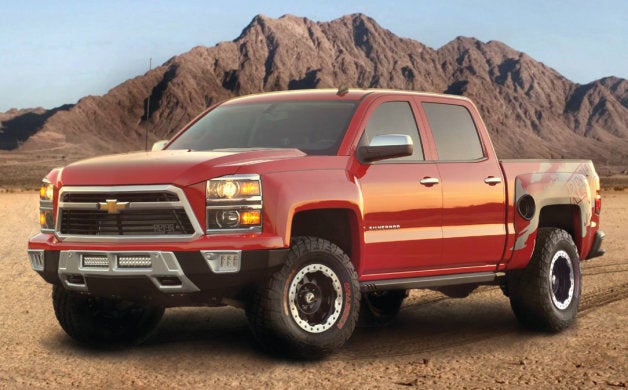
Moving on the the next truck that annoyed me. The new and hideous Reaper that was made by Lingenfelter Performance. This truck is very much so aimed at taking on the Raptor and whether it becomes something you can buy (if you could get over the hideous looks) is still up in the air. The biggest complaint I have with this truck is again about the suspension. Like the toyota and indeed the raptor, the chevy 15oo truck uses a Independent front suspension with two control arms and a coil around (crappier version of a coil-over) shock. The Reaper seems to have just changed out the coil spring/shock assembly of the truck and lifted it 3 inches but without changing any of the actual suspension geometry this truck is no better than any aftermarket lift for any regular 1500 chevy truck. The "lift" only allows for the larger tires which are what give it the increased ground clearance, but a 3" lift does not at all mean 3" of more travel. Yes the fox racing shock will provide better valving and dampening off road, and can be tuned for the drivers liking (all fox shocks can be rebuilt with new (different) internals to change valving etc) but with the same stock control arms, being the same length, and mounted at the same points on the frame, this is just a glorified chevy 1500 truck with a hideous front end and the same amount of travel in the suspension.
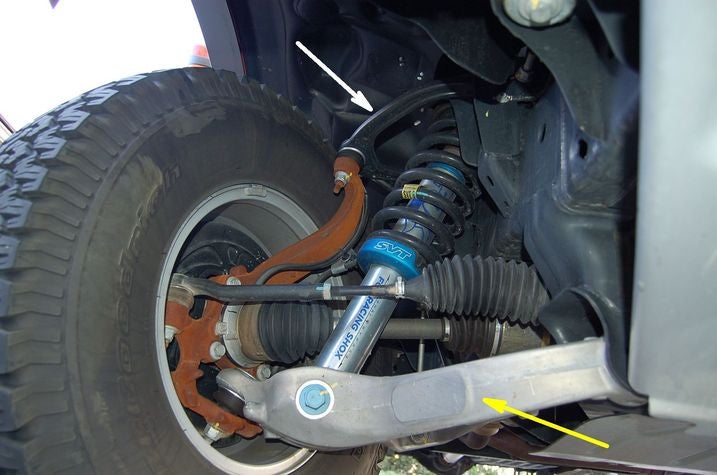
So to prove my point, the Raptor may look like an F150, but where it all changes is in the suspension. The suspension is completely different from a raptor to an F150 and this is what makes the raptor a much more capable off roader than any of the other trucks described today. Taking a look online there aren't many differences in the frame of a Raptor compared to the frame of a F150, but there are a few. The rear suspension has different pick up points to allow for longer shocks (that will actually translate to more travel). The front suspension may have the same mounting location on the frame but the control arms themselves are much different than a regular f150. They are thicker to handle more abuse, and they are also longer to allow for more travel. The front CV axles are beefier and longer to handle the added abuse that the truck will see and all of this coupled with the completely different Fox Racing coilovers makes the raptor the truck that it is.
So long story short, There has been no vehicle released yet that could be considered a competitor to the Raptor with the exception of the Ram Runner which you can't so much buy as build. And until another company actually makes real changes to the suspension/frame/drivetrain of a pickup to distinguish it from the model it is based off of, there won't be a valid competitor.
Sorry for such a long winded first post, I know that most people here aren't even fans of trucks in general and see any truck like this as a "bro truck" and i'm not here to get into any arguments about that. Yes I do drive a chevy truck. Yes it is a diesel. Any modifications I have done to it are to improve the efficiency of the engine as well as prolong the life of the truck. No it is not lifted and no i do not have any chrome suspension components. While I am not always using my truck as a "truck" I do tow plenty of trailers of all different shapes and sizes and weights and haul dirt bikes and other things frequently with it, and seeing as it is the only vehicle I could afford at the time I chose it because I needed a vehicle that would allow me to do all of these things.
I have recently graduated as a mechanical engineer from Cal Poly San Luis Obispo and now work as a Mechanical/Manufacturing/Process/Quality Engineer for a small research and development company that is designing and testing and manufacturing two stroke opposing piston diesel engines for a wide application of uses. So while I don't know everything I am pretty knowledgeable with regards to a lot of the engineering behind vehicles (have taken multiple suspension geometry design classes as well as internal combustion engine design and turbo machinery classes).
 Aaron James
> TJDMAX
Aaron James
> TJDMAX
02/07/2014 at 14:22 |
|
I think these trucks are more for looks than offroad performance like the Raptor. It will be interesting to see the actual specs and reviews on the TRD Pro's when they get closer to production. Welcome to OPPO (even though you've been here for a while)
 willkinton247
> TJDMAX
willkinton247
> TJDMAX
02/07/2014 at 14:33 |
|
Legit analysis, dude. Thanks!
 Slow4o
> TJDMAX
Slow4o
> TJDMAX
02/07/2014 at 14:56 |
|
Fantastic first post. Its great to hear this from an engineering perspective since I (and I assume quite a few other Jalops) know way more about cars than we do about the engineering of offroading. And don't worry about the truck hate, some people just like what they like. For example, my wife drives an FX2 EcoBoost because she likes being up high and in something big. The only thing we have ever towed is a UHaul trailer and a car once. But god damn is it not practical as hell to move stuff around, like dogs and car parts. And its comfortable as hell to drive/ride.
 HammerheadFistpunch
> TJDMAX
HammerheadFistpunch
> TJDMAX
02/07/2014 at 15:42 |
|
I think you are oversimplifying the suspension on the Toyotas.
1. They are DOUBLE A-arms and therefor do NOT travel in an ARC, but rather up and down (minus castor and camber) This is the same suspension setup on the Raptor. Their travel geometry is therefor not limited solely by lower arm length.
2. The assumption that a truck has a defined and narrow window of travel is false, or at least incomplete. There is more available motion in the arms than is currently used by the limits of stock suspension. Its typically the shock stroke that tops out and limits down travel. Put a truck or a lift and check out how far the wheels drop (way more than half the down travel), now take off the absorbers, and watch it drop even more. If you lift a truck properly, you gain travel, up and down. 1.25 is pretty conservative in terms of stroke increase and I'm sure its actually there. two reason: 1. If you lift and leave the bump stomps where they are you automatically net more up travel and if you allow the shock stroke to top out later you gain more down travel before you hit the hard limits of the upper control arm. and 2. They actually SAID that stroke length is increased (not just lift) you get both increased up and down travel with these shocks. They made a point to differentiate that you get a lift (between 1.5 and 2 inches) AND increased stroke length.
3. They didn't add a spacer to the coils, have you seen these coilovers? they are custom valved remote res. Fox units, why would they not source longer coils? That would be insane! A longer coil means more stroke, assuming the damper has sufficient stroked (it does) and the A-Arms are withing their hard stops (they are)
a good example would be a lifted Tacoma. Even with OME or other simple off the shelf kits, you net up and down travel and increased stroke that use the same principles. More coil +more shock stroke = more wheel travel. The A-arm equation is there but within the limits of lift we are talking about (2 inches at most) they are safely inside the comfort zone of the arm physical stops. its usually at 2.5-3 inches that upper A-arms need to be replaced, not because they are out of stroke, but because the changes that start to occur in castor and camber.
I agree with you that I don't think these trucks are Raptor fighters, they are more like: a little nicer to drive quickly on rutted road machines.
Toyota knows their suspension though, drive a TRD Tacoma, its a very nice ride for something with leaf springs and I have no doubt that these shock deliver on their performance promises of increased wheel travel and ride height. What makes them different from a pre-runner like the raptor is that they stopped short of making the extreme changes that would allow for large increases of travel. TRD is a separate company from Toyota after all (owned but but not tied in) and the goal here is as much to supply bolt on parts to existing trucks as it is to make a statement in terms of machoness. I mean, can you even imagine selling these parts with new lower and upper arms, totally revised CV's and bump stop relocation? nope.
 TJDMAX
> HammerheadFistpunch
TJDMAX
> HammerheadFistpunch
02/07/2014 at 16:23 |
|
My apologies. I haven't seen a whole lot of in depth stuff regarding the suspension of the Tundra/Tacoma/4Runner in particular and especially not the PRO trucks, but I appreciate you clarifying some points for me. I do have a couple counterpoints however.
1) I mispoke when I said they had control arm suspensions. All the trucks as far as I know have an upper and lower arm and a knuckle that connects the two together and where the cv shaft splines in and drives the wheel. The ARMS of a double A-Arm system do travel in an arc, the wheels (for all intensive purposes) travel straight up and down. The ball joints / uni-balls whatever they may be in the ends of the arm that join to the knuckle are what allow for the wheel to travel in a different arc from the arms. Usually the upper ball joint is a "plunge" style ball joint that will keep the wheel traveling vertically, and the lower ball joint is the one that looks most like a typical ball and socket joint and allows for the range of motion between the arms and knuckles. (Upper on the left, lower on the right)
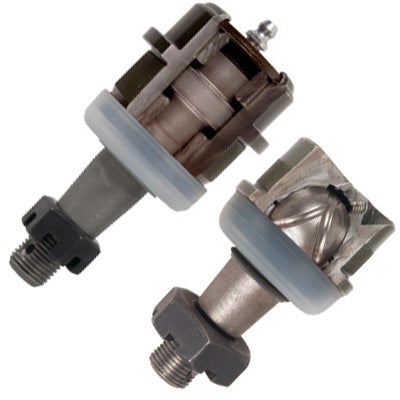
2) Yes you are right. A truck has mechanical limitations of the suspension components that limit its travel before the entire travel of the A-Arms and knuckle can be had. Shocks, axles, ball joints, wheel and tire size, all play a factor in limiting the amount of travel a truck actually has when it is released. What I meant was that without changing other components (axles, ball joints, bump stops, brake lines, etc) there is only so much travel that can be had or used in the truck. There is also limited amounts of room inside the wheel well for the tire to go and there has to be enough room for the wheel to be able to turn full lock to lock without rubbing or colliding into any part of the wheel well regardless of where it is in the travel of the suspension. Hence the reason why people extend the track width and add larger fenders on "pre-runner" trucks. I don't see any different modifications on the PRO trucks but again I also don't know how close the stock wheels were to hitting the wheel wells etc. I agree that on a coilover system you can gain more travel by introducing a longer spring and damper assembly but you are still limited by the other components. So if the ball joints and axles are either upgraded to allow for a wider range of motion, or came that way on a stock tundra to allow for more travel then I retract my argument, it would be possible to gain more travel by adding a longer assembly. 1.25" stroke length though still does not equate to a full 1.25" of travel out of the wheel. I haven't seen the numbers to compare what a stock tundra or trd tundra or the pro tundra have for wheel travel but I would be very interested to read that.
3) No I haven't seen the actual units they are using specifically for these trucks. I agree though, a longer assembly (coil and damper and body all together) would indeed result in more travel and lift.
I wasn't meaning to bash toyota or TRD or anybody who owns any of these trucks. I more-so just wanted to say that the Raptor is more than a regular F150 with some upgraded coilovers, and that to build a competitive truck to the Raptor (which I am very much in favor of seeing some competition) automakers are going to have to do more than just upgrade the shocks on an otherwise stock truck. I believe that the Raptor has a 7" overall wider front track width compared to a standard F150. Not a "long travel" suspension by any means but clearly wider than stock to allow for the much higher wheel travel for the raptor.
 HammerheadFistpunch
> TJDMAX
HammerheadFistpunch
> TJDMAX
02/07/2014 at 16:32 |
|
Didn't mean to get all up in your face about it. But I am pretty intimate with the suspension workings of Toyota's and the TRD program. I'm 100% confident that you are getting their claims of 1.25 more travel and 2 inches more ride height based on what I have seen of Tacoma and Tundra suspension components. These are going to be great riding trucks due to the increased down travel and speed sensitive valving, but a pre-runner they are not.
A good place to start looking would be articles on the TX pro , which is almost exactly the same as the TRD pro taco (or taco supreme as they are calling it) which does have increased wheel travel of 1.25 inches front and rear in addition to a lift.
 TJDMAX
> HammerheadFistpunch
TJDMAX
> HammerheadFistpunch
02/07/2014 at 16:44 |
|
You didn't get up in my face. I'm not angry or anything like that. I was just stating some facts but like I said I'm not familiar at all with the specifics of the Toyota or TRD trucks. I have been in multiple tacoma's and tundras both TRD and not and both off road and on the street. They are great riding trucks and no doubt these new ones will be too. I must have been confusing the specs on these new PRO trucks is all. Where I read a 1.25" longer stroke shock they must have meant a 1.25" increase in wheel travel. Even on that TX pro tacoma they installed 3" taller springs to get 1.5" of lift which only means 1.25" of increased travel. All I was saying is that a 1.25" longer shock doesnt mean 1.25" more travel.
For the sake of not beating a dead horse or sounding repetitive i think we are kind of going to start arguing the same point. I don't think either of us expects the PRO trucks to beat a raptor. I think they will be nice trucks for sure just not on the same level.
Again, Sorry for stepping on your toes. I really appreciate the insight as like I have said before I am not at all familiar with the workings of these trucks just of suspension systems in general. Which is a very vague generalization because there are many different types and setups and designs etc.....
 HammerheadFistpunch
> TJDMAX
HammerheadFistpunch
> TJDMAX
02/07/2014 at 16:50 |
|
Can I just say what a treat it is to have a civil and informative debate like this? This really is a great place to meet awesome people who like cars.
Its really the only social network worth a damn, in my opinion.
 TJDMAX
> HammerheadFistpunch
TJDMAX
> HammerheadFistpunch
02/07/2014 at 16:52 |
|
I agree. This could have been a much more heated argument and I was really not looking for that and thankful it didn't become that.
 Jeff-God-of-Biscuits
> HammerheadFistpunch
Jeff-God-of-Biscuits
> HammerheadFistpunch
02/07/2014 at 17:10 |
|
You guys both suck! I wanted an internet fight. lol
 Road Rebel
> TJDMAX
Road Rebel
> TJDMAX
08/14/2014 at 17:18 |
|
Pardon the timing on this reply. I just saw a comment on the reaper that linked to this article, which is very good by the way. This is not intended as an addition to any argument, just my 2 cents regarding longer shocks and additional travel...
On most trucks it is possible to get more suspension travel than stock with a longer shock. This may cause additional wear on your suspension components, particularly the upper arm ball joint, cv's and in some cases tie rod ends. It also can present unwanted suspension geometry changes at full droop. On most trucks a modest increase in travel is not a concern as long as the droop is limited by the shock or limiting strap and not the ball joint. This is because suspensions don't spend much time at full droop. In fact an increase in ride height is much more of a concern as the components are constantly at more extreme angles where they wear more quickly.
An increase in shock stroke on almost all vehicles with independent suspension will net a larger increase in wheel travel. Different trucks have different geometries but in all modern trucks with independent front suspensions the ratio of wheel travel to shock travel is always greater than 1:1, usually between 1.4:1 and 1.8:1.
For Example: I recently replaced the stock shocks on my Chevrolet Tahoe with height adjustable Bilstein 5100s. These Bilsteins have 3 different spring perch positions for varying amounts of lift, and are longer by 3/4" they also have the same compressed length as the stock shocks. This means that they bump at the same position as stock, and extend 3/4" further which increases wheel travel. This was important to me as I intended to level the truck with them but did not want to lose down travel as that can produce a "pogo stick" like ride. I measured droop before and after installation, the additional 3/4" at the shock netted 1.25" at the wheel in full droop. Indicating that the wheel travel to shock travel ratio on 1500 series GMT900 trucks is 1.66:1. With the additional extension the ball joint does not bind and because the spring perch I chose lifted the truck 1.5" I only lost .25" of down travel. The ride quality is greatly improved both on and off pavement.
From what I understand this is the same thing that Toyota has done with the TRD Pro's, they have added longer shocks with higher spring perches to provide lift without reducing down travel. Along with more aggressive valving and a possible change in spring rate this should have a very positive effect on the ride and handling of the TRD Pro trucks, as opposed to their more pedestrian counterparts.
 TJDMAX
> Road Rebel
TJDMAX
> Road Rebel
08/14/2014 at 17:49 |
|
No worries on the late response. You bring up a lot of good points and I agree with all of them. There is a little to be gained in terms of travel when you put a longer shock/coil over on an IFS vehicle. Limitations are still found though in the other components (like you mentioned ball joints CV's etc) and regardless of the length of the shock, the path of the wheel is still going to be the same as long as the control arms remain the same.
When you changed out the coil on your tahoe and you measured the down travel did you also measure the up travel? I have a 06 Chevy 2500hd with torsion bars and i have upgraded shocks on the truck. In my situation I lifted the truck by cranking the torsion bars a little to bring it "level" and the longer shocks provided me the extra length needed to allow for increase in down travel but I am still limited in the same position for the up travel by the bump stops. So essentially I "gained" down travel but really what happened was the truck was lifted an inch or so thus making it seem like the suspension was in a lower position than stock...if that makes any sense. The longer shock just allowed for more travel to be had but following the same wheel path as stock because the lower control arm is still stock.
I would imagine something similar happened to your Tahoe as well. By lifting it, you basically forced the wheel down more, pushing the body up, giving you your lift. So yes you will gain down travel (which is good) but its not a huge increase either....not like the difference between a stock F150 and a Raptor.
And this isn't supposed to sound mean or anything. I appreciate the comment and let me know if you think my insight or opinion is wrong or something...
 Road Rebel
> TJDMAX
Road Rebel
> TJDMAX
08/14/2014 at 19:05 |
|
I did not take the time to measure the up travel. The eye to eye measurement fully compressed on both the stock and the Bilstein shock was essentially the same. I also don't think the suspension bottoms with the shock at full compression, it hits the bump stop first. As the compressed shock length did not change there is no way that the shock would limit maximum up travel in any way. However by increasing the ride height, the amount of wheel travel from ride height to full compression was increased by the amount of lift added. In my case 1.5". So all in all I gained 1.5" of up travel, and lost a quarter inch of down travel over the stock shocks. A total of 1.25 inches of increased wheel travel from full compression to full droop.
It sounds like you accomplished the same thing on your truck. Cranking the torsion bars is essentially the same as changing the spring perch position on a coilover or strut. The spring rate is not increased, but the suspension height at which the spring counters the static load is now changed. If you cranked the torsions to the point where your ride height was 2" higher than before you gained 2" of up travel and lost 2" of down travel. Depending on how much additional droop you gained from your extended shocks you will have gained back some or all of the lost down travel. Assuming the extended shocks did not prevent the suspension from achieving the same amount of compression this also would indicate an increase in total wheel travel of the same amount the droop was increased. My guess is that with an extended shock you gained around 1" of droop or wheel travel. Meaning that with your torsion lift you gained 2" of up travel, lost around 1" of down travel, for a total gain of around 1" of total wheel travel.
Neither of these are similar to the difference between a stock F150 and a Raptor. To achieve that kind of increased travel on any IFS vehicle requires a much longer shock, and a new upper control arm, usually with a uniball. This will allow for droop much further than the stock ball joint will allow. I used to have a 06 Tundra, I added 2.5" coilovers and uniball upper control arms. This setup provided over 3' of additional travel. An increase similar to that of the Ford Raptor over the stock F150. My Tundra was still 2" shy of the total travel the Raptor has since the stock F150 has more travel than the stock Tundra. A similar setup on the F150 puts its wheel travel within .5" of the Raptors, albeit usually with a smaller increase in track width.
Its easy to get caught up in thinking wheel travel is the most important factor in offroad performance. The increase on my Tundra improved performance, however the real magic is in the valving and spring rates. My suspension both front and rear was custom valved and sprung by Bill West of Team West, this made the truck handle like a dream in the dirt. Every single person I gave rides to offroad was amazed by how smooth it was. I was even told by someone that it provided a smoother ride down a particular road than another friends long travel Silverado that had 6 inches more travel than my truck, this was undoubtedly due to the differences between a properly sprung and valved setup and one that had been mickey moused together.
If either the new TRD PRO or the Reaper have spring and valving setups geared towards offroad performance they may be closer to equaling the Raptors offroad ride than we think. However my guess is that Toyota and Chevrolet compromised on the suspension setup to make sure they have "acceptable" street manners, and therefore will not come close.